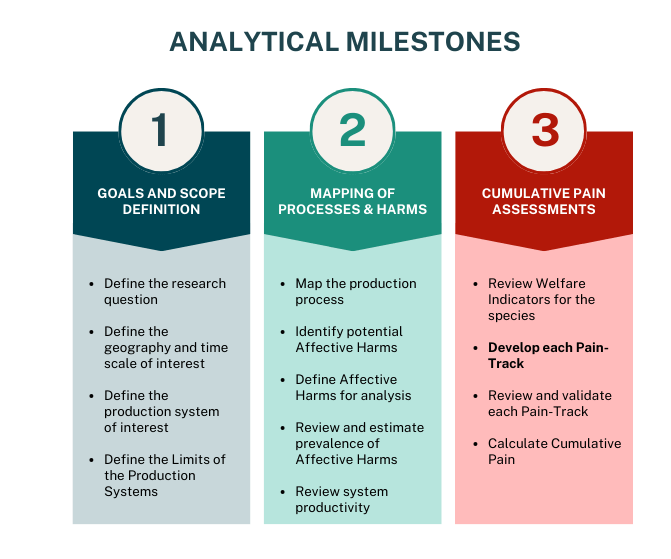This page compiles resources and protocols for those interested in implementing the Cumulative Pain metric, to a research question of interest. It is divided into four suggested analytical milestones, as illustrated below.

The first two milestones (1. Goal and Scope Definition, 2. Mapping of Processes) can be used by researchers using any welfare assessment method, as the protocols in these milestones can help identify relevant harms affecting animals in any production context.
This page will be continuously updated as new protocols and material becomes available.
Protocol for Defining the Goals and Scope of Analysis
This protocol is designed to guide researchers, organizations, policy-makers, and industry stakeholders in systematically establishing the goal and scope for welfare assessments, including the definition of the research question, the temporal and spatial scale, the production systems of interest and their limits.
Animal production systems encompass various production stages and practices where opportunities to either cause or prevent harm to animal welfare arise. Gaining a deep understanding of these systems and their typical variability is crucial to create a comprehensive map of potential affective harms and estimate their likely prevalence, duration and severity.
Protocol to Mapping Animal Production Processes and Potential Affective Harms
We recommend using process flowcharts to dissect animal production systems. By highlighting distinct paths, it facilitates a deeper understanding of these processes and their varying impacts on animal welfare .
Protocol to identify Affective Harms emerging from changes in external and internal factors
Different life phases pose distinct challenges. We suggest using diagrams to map these conditions and their interactions for a specific life phase, hel[ing identify and assess their welfare impacts.
Protocol for Identifying and Selecting Affective Harms
Certain affective harms can exhibit significant variations in severity and/or duration. This protocol is designed to help researchers in the choice of harms and the corresponding Pain-Tracks that will quantify the magnitude of pain endured as a consequence in different contexts.
The main task in this Milestone, and the heart of Cumulative Pain assessment, is the development of one Pain-Track for each Affective Harm (synonymous with ‘pain’ in our operational definition), which involves developing hypotheses for the intensity and duration of each of the affective experiences identified in the previous sections. This is a critical task, likely to be the most laborious and time-consuming stage of the entire analytical process.
The approach is detailed in the first chapter of the book, ‘Quantifying Pain in Laying Hens: A Blueprint for the Comparative Analysis of Welfare in Animals’. The Pain-Track notation tool, an essential part of this framework, is described in a scientific paper that primarily addresses human pain in the medical field. For additional information, please refer to the answers to frequently asked questions.
If you are interested in further in-depth training, or discussing your research question with us, you can book a Virtual Office Hour session, or directly apply for a workshop (offered in flexible formats and durations, tailored to each specific need).
